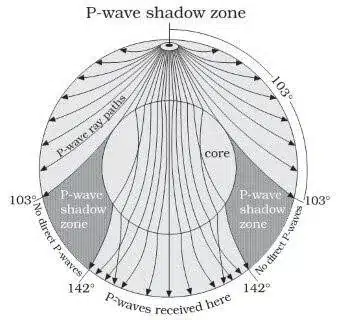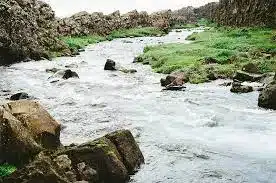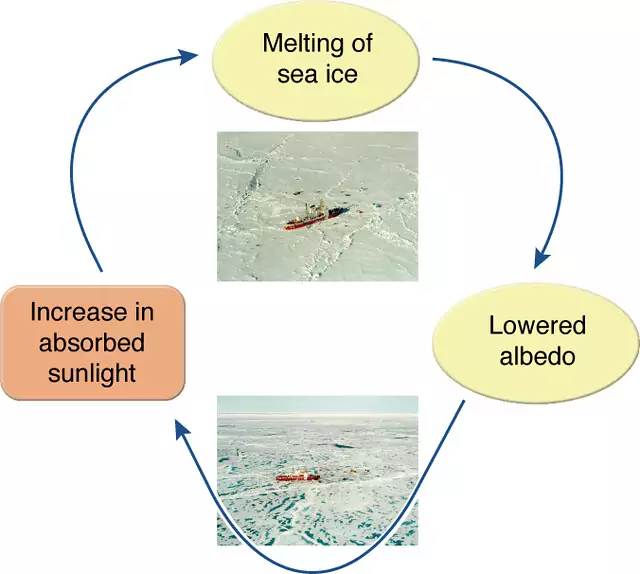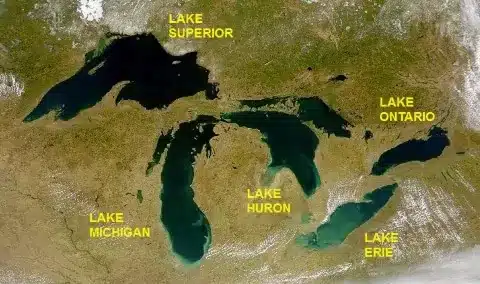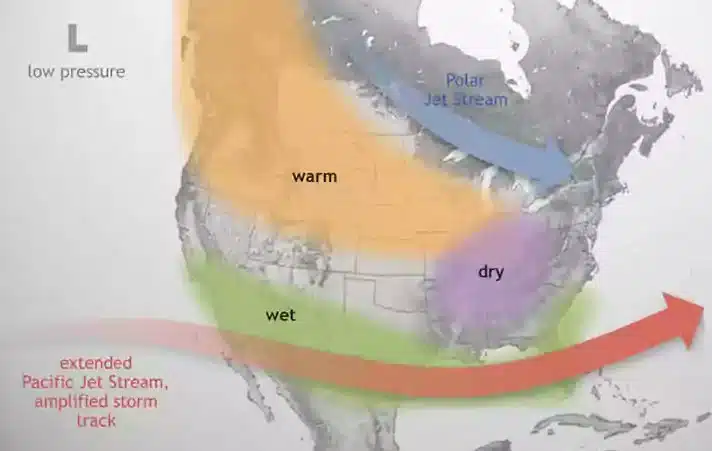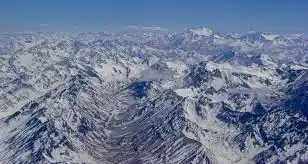Atmospheric Pressure
Atmospheric Pressure is nothing but a column of the weight of air in a particular unit area from the mean sea level to the top of the atmosphere. Atmospheric pressure is also called barometric pressure. The pressure is measured in force per unit area.
- The atmospheric pressure is expressed in the ‘millibar’’ or ‘mb’ unit.
- The atmospheric pressure can also be measured with the help of a mercury barometer.
- To check the pressure the height of the column of the mercury should match the weight of the column of the atmosphere in the mercury barometer, and we can also measure the pressure with the help of an android barometer.
- The atmospheric pressure is stated as kilo-pascals at the application level.
- The mercury barometer or aneroid barometer is used to measure the atmospheric pressure.
- The pressure decreases rapidly with height in the lower level of the atmosphere.
- The horizontal pressure gradient force is much smaller than that of the vertical pressure.
- In the center, the lowest pressure is the isobars of the low-pressure is encircled by one or more isobars.
- In the center, the highest pressure is the isobars of the high-pressure is encircled by one or more isobars.
- Isobars are connecting the lines and it has equal pressure.
Atmospheric pressure is an indicator of weather. When a low-pressure systems moves into an area, it usually leads to cloudiness, wind, and precipitation. High-pressure systems usually lead to fair, calm weather.
Forces Affecting the Velocity and Direction of Wind
- The air is set in motion due to the differences in atmospheric pressure.
- The air in motion is called wind. The wind blows from high pressure to low pressure.
- The wind at the surface experiences friction. In addition, rotation of the earth also affects the wind movement.
- The force exerted by the rotation of the earth is known as the Coriolis force.
- Thus, the horizontal winds near the earth surface respond to the combined effect of three forces – the pressure gradient force, the frictional force and the Coriolis force.
- In addition, the gravitational force acts downward.
Pressure Gradient Force
- The differences in atmospheric pressure produces a force.
- The rate of change of pressure with respect to distance is the pressure gradient.
- The pressure gradient is strong where the isobars are close to each other and is weak where the isobars are apart.
- The pressure gradient is expressed in units of pascals per meter.
- The horizontal pressure gradient force is directed from higher toward lower pressure.
- To make wind, the pressure gradient acts as the main force in the air.
- If the pressure gradient is negative it is known as the force density.
Frictional Force
- It affects the speed of the wind. It is greatest at the surface and its influence generally extends up to an elevation of 1-3 km. Over the sea surface the friction is minimal.
Coriolis Force
- The rotation of the earth about its axis affects the direction of the wind.
- This force is called the Coriolis force after the French physicist who described it in 1844.
- It deflects the wind to the right direction in the northern hemisphere and to the left in the southern hemisphere.
- The deflection is more when the wind velocity is high.
- The Coriolis force is directly proportional to the angle of latitude.
- It is maximum at the poles and is absent at the equator.
- The Coriolis force acts perpendicular to the pressure gradient force.
- The pressure gradient force is perpendicular to an isobar.
- The higher the pressure gradient force, the more is the velocity of the wind and the larger is the deflection in the direction of wind.
- As a result of these two forces operating perpendicular to each other, in the low- pressure areas the wind blows around it.
- At the equator, the Coriolis force is zero and the wind blows perpendicular to the isobars.
- The low pressure gets filled instead of getting intensified.
- That is the reason why tropical cyclones are not formed near the equator.
Pressure and Wind
- The velocity and direction of the wind are the net result of the wind generating forces.
- The winds in the upper atmosphere, 2-3 km above the surface, are free from frictional effect of the surface and are controlled mainly by the pressure gradient and the Coriolis force.
- When isobars are straight and when there is no friction, the pressure gradient force is balanced by the Coriolis force and the resultant wind blows parallel to the isobar. This wind is known as the geostrophic wind.
- The wind circulation around a low is called cyclonic circulation. Around a high it is called anti cyclonic circulation.
- The direction of winds around such systems changes according to their location in different hemispheres.
- The wind circulation at the earth’s surface around low and high on many occasions is closely related to the wind circulation at higher level.
- Generally, over low pressure area the air will converge and rise.
- Over high pressure area the air will subside from above and diverge at the surface.
- Apart from convergence, some eddies, convection currents, orographic uplift and uplift along fronts cause the rising of air, which is essential for the formation of clouds and precipitation.
Units to Measure Atmospheric Pressure
There are seven different ways to measure atmospheric pressure.
- Millimeters (Inches of mercury)
- Pounds per square inch (psi)
- Dynes per square centimeter
- Millibars (mb)
- Kilopascals
Standard Sea Level Pressure in Units
- The atmospheric pressure on the surface of the earth in millimeters is 760 or 29.9 inches of mercury.
- The atmospheric pressure on the surface of the earth in pounds per square inch is 14.70
- The atmospheric pressure on the surface of the earth in dynes per square inch is 1,013.25 × 103.
- The atmospheric pressure on the surface of the earth in millibars is 1,013.25.
- The atmospheric pressure on the surface of the earth in kilopascals is 101.325.
Factors Controlling Pressure Systems
There are two main causes, thermal and dynamic, for the pressure differences resulting in high and low-pressure systems.
Thermal Factors
- When air is heated, it expands and, hence, its density decreases. This naturally leads to low pressure. On the contrary, cooling results in contraction. This increases the density and thus leads to high pressure.
- Formation of equatorial low and polar highs are examples of thermal lows and thermal highs, respectively.
Dynamic Factors
- Apart from variations of temperature, the formation of pressure belts may be explained by dynamic controls arising out of pressure gradient forces and rotation of the earth (Coriolis force).
Vertical Distribution
- The columnar distribution of atmospheric pressure is known as the vertical distribution of pressure.
- The mass of air above in the column of air compresses the air under it hence its lower layers are denser than the upper layers; As a result, the lower layers of the atmosphere have higher density, hence, exert more pressure.
- Conversely, the higher layers are less compressed and, hence, they have low density and low pressure.
- The temperature of the air, the amount of water vapor present in the air, and the gravitational pull of the earth determine the air pressure of a given place and at a given time.
- Since these factors are variable with a change in height, there is a variation in the rate of decrease in air pressure with an increase in altitude.
- Rising pressure indicates fine, settled weather while falling pressure indicates unstable and cloudy weather.
Horizontal Distribution
The factors responsible for variation in the horizontal distribution of pressure are as follows:
- Air temperature – Equator Polar regions
- The earth’s rotation – Coriolis force
- Presence of water vapor – Inversely related to pressure
Air Temperature
- Earth is not heated uniformly because of unequal distribution of insolation, differential heating and cooling of land and water surfaces
- Air pressure is low in equatorial regions and it is higher in polar regions.
- Low air pressure in equatorial regions is due to the fact that hot air ascends there with a gradual decrease in temperature causing thinness of air on the surface.
- In the polar region, cold air is very dense hence it descends, and pressure increases.
The Earth’s Rotation
- The earth’s rotation generates centrifugal force.
- This results in the deflection of air from its original place, causing a decrease of pressure.
- The low-pressure belts of the subpolar regions and the high-pressure belts of the sub-tropical regions are created as a result of the earth’s rotation.
Presence of Water Vapour
- Air with a higher quantity of water vapor has lower pressure and that with a lower quantity of water vapor has higher pressure.
Pressure Belts
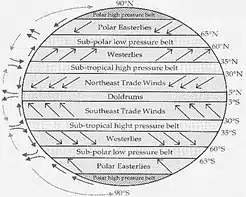
There is a pattern of alternate high and low-pressure belts over the earth. There are seven pressure belts in the atmospheric pressure. There are two subtropical highs in north and south and two subpolar lows in north and south and the two polar highs in north and south except for the equatorial low. The pressure belts oscillate with the movement of the sun. They move southwards in the winter season and they move northwards in the summer in the northern hemisphere.
- The horizontal distribution of air pressure across the latitudes is characterized by high or low pressure belts.
- This is however, a theoretical model because pressure belts are not always found as such on the earth.
- These pressure belts are:
- Equatorial Low
- The two Sub-tropical Highs
- The two Sub-polar Lows
- The two Polar Highs.
Equatorial Low Pressure Belts
- The sun shines almost vertically on the equator throughout the year.
- As a result the air gets warm and rises over the equatorial region and produce equatorial low pressure.
- This low-pressure belt extends from 0 to 5° North and South of the Equator.
- Due to excessive heating horizontal movement of air is absent here and only conventional currents are there.
- Therefore this belt is called doldrums (the zone of calm) due to virtual absence of surface winds.
- These are the regions of convergence because the winds flowing from sub tropical high pressure belts converge here.
- This belt is also known as-Inter Tropical Convergence Zone (ITCZ).
Sub-tropical High Pressure Belts
- At about 30°North and South of the Equator lies the area where the ascending equatorial air currents descend. This area is thus an area of high pressure.
- The existence of these pressure belts is due to the fact that the up rising air of the equatorial region is deflected towards poles due to the earth’s rotation.
- After becoming cold and heavy, it descends in these regions and get piled up. This results in high pressure.
- Calm conditions with feeble and variable winds are found here.
- Winds always blow from high pressure to low pressure.
- So the winds from the subtropical region blow towards the Equator as Trade winds and another wind blow towards Sub-Polar Low-Pressure as Westerlies.
- These diverging winds are the result of an area of high pressure, which is characterized by calm winds, sunny skies, and little or no precipitation.
- In olden days vessels with cargo of horses passing through these belts found difficulty in sailing under these calm conditions.
- They used to throw the horses in the sea in order to make the vessels lighter. Henceforth these belts or latitudes are also called ‘horse latitudes’.
- These are the regions of divergence because winds from these areas blow towards equatorial and subpolar low pressure belts.
Sub-polar Low Pressure Belts
- The sub-polar low pressure belts extend between 45 º N and the Arctic Circle in the northern hemisphere and between 45°S and the Antarctic Circle in the southern hemisphere.
- They are known as the North sub-polar low and the South sub-polar low pressure belts respectively.
- This zone is marked by the ascent of warm Sub-tropical air over cold polar air blowing from poles. Due to earth’s rotation, the winds surrounding the Polar region blow towards the Equator.
- Winds coming from the sub-tropical and the polar high belts converge here to produce cyclonic storms or low pressure conditions.
- This zone of convergence is also known as polar front.
Polar High Pressure Areas
- In polar regions, sun never shines vertically.
- Sun rays are always slanting here resulting in low temperatures.
- Because of low temperature, air compresses and its density increases. Hence, high pressure is found here.
- In northern hemisphere the belt is called the North polar high pressure belt while it is known as the South polar high pressure belt in the southern hemisphere.
- Winds from these belts blow towards sub-polar low pressure belts.
- These regions are characterized by permanent IceCaps.
Shifting of Pressure belts
- This system of pressure belts is a generalised picture.
- In reality, the location of these pressure belts is not permanent.
- They shift northward in July and southward in January, following the changing position of the sun’s direct rays as they migrate between the Tropics of Cancer and Capricorn.
- The thermal equator (commonly known as the belt of highest temperature) also shifts northwards and southwards of the equator.
- With the shifting of thermal equator northwards in summer and southwards in winter, there is also a slight shift in pressure belts towards north and south of their annual average location.
Pressure belts in July
- In the northern hemisphere, during summer, with the apparent northward shift of the sun, the thermal equator (belt of highest temperature) is located north of the geographical equator.
- The pressure belts shift slightly north of their annual average locations.
Pressure belts in January
- During winter, these conditions are completely reversed and the pressure belts shift south of their annual mean locations. Opposite conditions prevail in the southern hemisphere. The amount of shift is, however, less in the southern hemisphere due to the predominance of water.
- Similarly, the distribution of continents and oceans have a marked influence on the distribution of pressure. In winter, the continents are cooler than the oceans and tend to develop high-pressure centers, whereas, in summer, they are relatively warmer and develop low pressure. It is just the reverse with the oceans.
Also refer :

